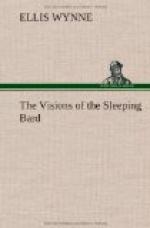{48c} A huge, seething cauldron.—This was the mystical cauldron of Ceridwen which Taliesin considered to be the source of poetic inspiration. Three drops, he avers, of the seething decoction enabled him to forsee all the secrets of the future.
{48d} Upon the face of earth.—These lines occur in a poem of Taliesin where he gives an account of himself as existing in various places, and contemporary with various events in the early eras of the world’s history—an echo of the teachings of Pythagoras:
Morte carent animae; semperque priore relicta
Sede, novis habitant domibus vivuntque receptae.
—Ovid: Metam. XV. 158-9.
{48e} Taliesin.—Taliesin is one of the earliest Welsh bards whose works are still extant. He lived sometime in the sixth century, and was bard of the courts of Urien and King Arthur.
{49a} Maelgwn Gwynedd.—He became lord over the whole of Wales about the year 550 and regained much territory that had once been lost to the Saxons. Indeed Geoffrey of Monmouth asserts that at one time Ireland, Scotland, the Orkneys, Norway and Denmark acknowledged his supremacy. Whatever truth there be in this assertion, it is quite certain that he built a powerful navy whereby his name became a terror to the Vikings of the North. In his reign, however, the country was ravaged by a more direful enemy—the Yellow Plague; “whoever witnessed it, became doomed to certain death. Maelgwn himself, through Taliesin’s curse, saw the Vad Velen through the keyhole in Rhos church and died in consequence.” (Iolo MSS.)
{49b} Arthur’s quoit.—The name given to several cromlechau in Wales; there is one so named, near the Bard’s home, in the parish of Llanddwywe, “having the print of a large hand, dexterously carved by man or nature, on the side of it, as if sunk in from the weight of holding it.” (v. Camb. Register, 1795.)
{54a} In the Pope’s favor.—Clement XI. became Pope in 1700, his predecessor being Innocent XII.
{55a} Their hands to the bar.—Referring to the custom (now practically obsolete) whereby a prisoner on his arraignment was required to lift up his hands to the bar for the purpose of identification. Ellis Wynne was evidently quite conversant with the practice of the courts, though there is no proof of his ever having intended to enter the legal profession or taken a degree in law as one author asserts. (v. Llyfryddiaeth y Cymry, sub. tit. Ellis Wynne.)
{67a} “The Practice of Piety.”—Its author was Dr. Bayley, Bishop of Bangor; a Welsh translation by Rowland Vaughan, of Caergai, appeared in 1630, “printed at the signe of the Bear, in Saint Paul’s Churchyard, London.”
{69a} At one time cold.—Cp.:
I come
To take you to the other shore across,
Into eternal darkness, there to dwell
In fierce heat and in ice.
- Dante: Inf. c. III. (Cary’s trans.).
{71a} Above the roar.—Cp.:




